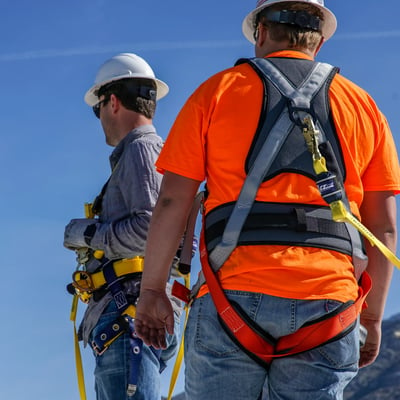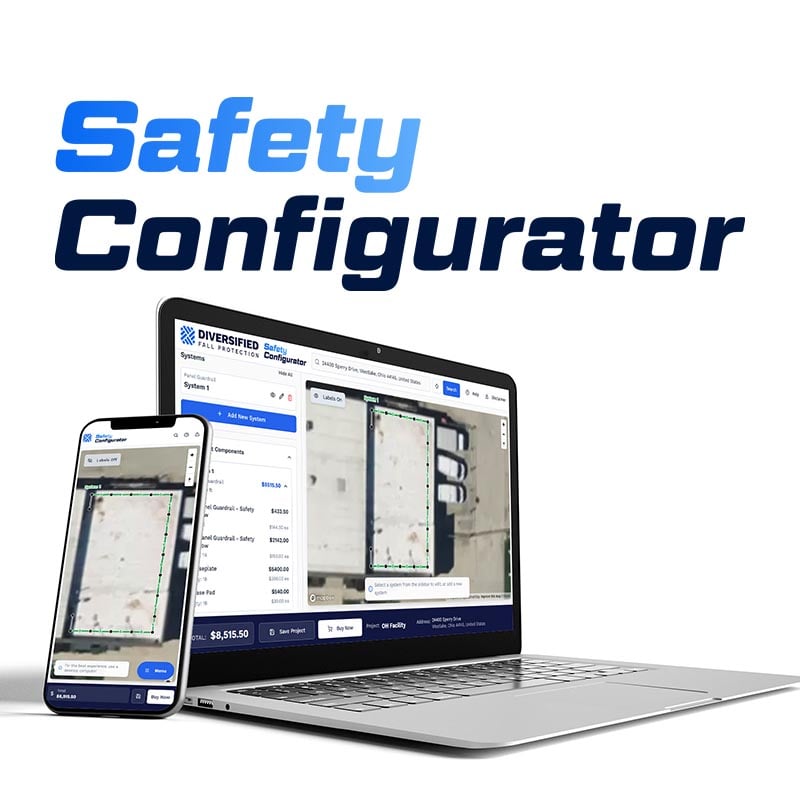
How to Conduct A Fall Hazard Assessment
Falls continue to be a leading cause of injury & fatality in the workplace. One way to prevent falls and mitigate hazards is to routinely perform fall hazard assessments in your facility. Routine hazard assessments can also be helpful in ensuring previously identified hazards have been adequately addressed and users are complying with corporate safety policies. Additionally, they can provide frontline workers & safety leadership an opportunity to discuss whether specific control measures should be modified to aid in worker productivity or identify areas where workers need additional training.
At Diversified Fall Protection, we’ve coined the APRON(S) Method to provide an efficient roadmap to guiding your rooftop hazard assessments (however, this method can be used for interior fall hazard assessments as well).The APRON(S) Method consists of:
Access Points
Perimeter
Rooftop Equipment
Openings
Navigation
Suspended Access
%20method.webp?width=1751&height=871&name=APRON(S)%20method.webp)
Access Points
If a fixed ladder is used to access the roof, verify the ladder height. Per OSHA 1910.28, all fixed ladders 24ft or greater (20ft or greater in California) must be equipped with a personal fall protection system or ladder safety system as of November 2018. If a ladder was installed before November 2018, the property owner has until November 2036 to perform the retrofit. However, if the ladder undergoes any maintenance, repair, maintenance, or construction, the retrofit must be performed at that time. If the ladder has a cage installed on it, the cage must only be removed if it prohibits the installation of the fall protection system. Furthermore, ladders used to access the rooftop must extend a minimum of 42” above the roofline to give workers adequate leverage to safely enter/exit the ladder.
If a roof hatch is used to access the roof, verify there is guardrail around the perimeter of the hatch opening equipped with a self-closing gate. Self-closing swing gates are crucial to include because an open hatch is considered a hole or opening, according to OSHA, and could cause serious injury if a worker accidentally falls through it. If the fixed ladder that leads to the hatch is 24ft or taller, that ladder would also be eligible for the OSHA 1910.28 update mentioned above.
Additionally, opening/closing hatch doors can require a user to remove one hand from the ladder, decreasing stability. When a user is entering/exiting the hatch is the most likely time a fall will occur. The Automatic Roof Hatch Opener (ARHO) offers workers the ability to open & close the hatch door before beginning their ladder climb, making accessing the roof much safer.
Perimeter
Once upon the rooftop, determine whether the existing perimeter of the roof provides any form of fall protection. Many rooftops have some sort of parapet around the perimeter, but that does not automatically equate to adequate fall protection. Parapet walls must meet minimum guardrail height requirements (39 inches) to be considered OSHA-compliant. Any parapet shorter will not provide fall protection and could even be considered a tripping hazard for workers.
Ideally, every building would have guardrail or high parapets permanently installed around the perimeter of the rooftop. If that were the case, many fall hazards would be eliminated and workers on rooftops everywhere would be considerably safer.
Rooftop Equipment
If there is insufficient fall protection around the perimeter of the roof, make note of all rooftop equipment that is within 15ft of the roof’s edge and the frequency that equipment must be accessed or maintained. Rooftop fall protection requirements are primarily determined by the frequency of the work performed and the proximity to the edge of the roof.
OSHA differentiates the frequency of work by infrequent & temporary and regular & routine. Infrequent & temporary work refers to tasks that last two hours or less. Some examples of this type of work include emergency maintenance, fall hazard assessments, or visual inspections. All other tasks are considered regular & routine, or jobs that are part of a daily, weekly, or regular schedule.
A worker’s proximity to the roof's edge is the other factor in determining what type of fall protection is required by OSHA. Regular & routine work performed within 15ft of the roof’s edge requires active or passive fall protection systems. There is an exception that allows Warning Line for infrequent & temporary work performed within 6ft of the roof’s edge.
Less fall protection is required once workers are greater than 15 feet from the roof’s edge. At that distance, Warning Line is deemed acceptable for regular & routine work. At the same time, no fall protection is required for infrequent & temporary work as long as a safety monitor or other administrative controls are in place.
Openings
During the assessment, locate any holes or openings on the rooftop. OSHA defines any gap, void, or opening at least 2 inches in its smallest dimension as a potential slip, trip, or fall hazard that must be mitigated. For holes or openings too small for someone to fall through, a barrier must be installed to protect a worker from accidentally stepping into the hole and tripping.
Skylights are an overlooked hazard, but OSHA mandates fall protection wherever they exist. Between 2015 and 2021, OSHA reports indicate 75 workers died from falls through skylights, and an additional 130 workers were severely injured. Luckily, the solution is a quick fix: skylight screens can be directly installed on the skylight to protect workers. Without a screen or another form of fall protection, someone falling onto a skylight would just fall through—severely injuring themselves and traumatizing anyone present inside when the fall occurs.
Navigation
As the inspection continues, make note of any ductwork, piping, or other equipment obstructing clear, safe passage while navigating the rooftop. These obstructions can be tripping hazards, causing workers to slip, trip, or fall. While falls to a lower level comprise most fall injuries & fatalities, about 20% of fall fatalities were due to falls on the same level. A fall from any height—even from standing and falling onto the same walking working surface can result in severe injuries or death. These obstructions can trip workers in clear weather, and in snowy conditions, they may become utterly invisible to workers trying to navigate around them. It is best practice to move any of these obstacles, if possible. If not, then utilizing crossovers or elevated walkways can provide workers with safe passage to their destination.
Additionally, the assessment should note what routes workers take while navigating the roof. As much as possible, workers should attempt to stay 15ft or more from the roof’s edge at all times. If employers notice that there is not a clear, direct navigation path between the access point and the rooftop equipment, they can add guardrail “corridors” that can control the path users take and decrease the need for more robust fall protection systems. By designating a safe path for employees to access the areas they need, employers & building owners can eliminate hazards and ensure employees do not walk into dangerous or restricted areas.
Suspended Access
The final part of the ARPON(S) method will not apply to all buildings. If the building being assessed is less than 3 stories tall and does not have many windows or glazed structure, exterior maintenance or window washing will likely be completed from the ground using ladders or mobile elevated work platforms (MEWPs). However, suspended access solutions are necessary for buildings that require specialized exterior maintenance or window washing. There are many solutions available in the marketplace that vary in complexity, but for conciseness purposes, this article will only focus on Rope Descent Systems and Ground-Rigged Platforms (GRM).
Rope Descent Systems (RDS) consist of two anchorages: one connecting the primary line to a bosun’s chair, lowering a worker to where they need to perform building maintenance or cleaning; and a secondary anchorage attached to a Class 2 Self-Retracting Lifeline (SRL) to protect the user if they fall or their primary line fails. If the building edge, be a flat-edge or parapet wall, cannot withstand loading, outrigger beams or davit arms must be utilized to elevate the rope & connect into the system. Outriggers must be fixed to a certified anchor, they cannot simply be ballasted or use counterweights. For buildings between 130-300ft, at-work stabilizers, like suction cups, must be utilized to protect workers from wind sway. RDS are not permitted on buildings over 300ft.
Ground-Rigged Powered Platforms (GRPPs), often referred to as “swing stages,” are more complex. These platforms have lines that are dropped down from the rooftop, connect to the powered platform, and then are rigged to the ground below for further stability. Typically, an independent contractor will own the powered platform, and the building owner will own the anchors or davit arms in which the GRPP connects. For buildings under 130ft, GRPPs can utilize angulated rope techniques to protect platforms from wind sway. But buildings between 130-300ft must use continuous-engagement or Intermitted Stabilization Anchors (ISAs).
While buildings between 130-300ft permit the use of ISAs for GRPP systems, we recommend against this practice. Traveling between the pins can give the platform the opportunity to sway in high winds and potentially cause workers to fall. Moreover, ISAs are difficult to retrofit into buildings and should be installed during initial construction. For these reasons, we recommend RDS systems at this height interval, as an individual worker will encounter less wind sway than a large platform at this height, and the workers will be less likely to fall.
For buildings 300-490ft, roof-launched powered platforms or “dedicated” systems are required. These systems are custom-designed for buildings and will likely need to be installed during initial construction. For buildings over 490ft, Building Maintenance Units (BMUs) are required. BMUs are mechanical devices that utilize gondolas or gantries, which systemically move workers over the structure of the surface.
It is not necessarily the responsibility of the assessor to configure an exterior building maintenance system, but they should be able to identify which system is required per the building height. They should help contractors or vendors identify where anchorages can be installed and if any current anchors in place are up-to-date on certification requirements. All anchors used in any kind of suspended access solutions must be certified by a qualified person and recertified every ten years.
Conclusion
Every rooftop is unique and can contain a wide array of fall hazards. However, using the APRON(S) method to perform your rooftop fall hazard assessments is a way to identify & mitigate all hazards in a concise, consolidated way. Also, it’s important to remember that you don’t have to go at it alone! Our nationwide team of local fall protection specialists is happy to accompany you on your fall hazard assessments to help you understand how to meet OSHA & ANSI compliance and provide turnkey solutions for your facility.
Together, we can make every rooftop safe, prevent avoidable tragedies, and save lives!
Schedule an assessment with Diversified Fall Protection
Contact Us to request a fall safety review

b-1.jpg?width=1368&height=1340&name=Rail%20(175)b-1.jpg)

